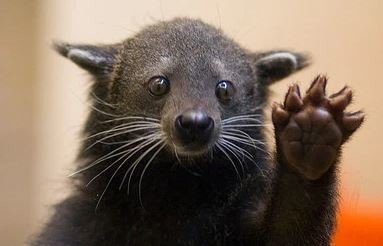Why These Weird Carnivores Smell Like Popcorn
Wander through the forests of southeast Asia, and you might suddenly wonder if there’s a movie theatre nearby. That’s because parts of Thailand, Malaysia, Vietnam and Indonesia are home to the binturong— a cat-like carnivore with pee that smells like buttered popcorn.

Yum? Binturongs—or bearcats as they’re sometimes called, though they aren’t closely related to bears or cats— like to hang out high in the trees of dense forests where they can avoid ground-dwelling predators while they snack on fruit, insects, small rodents, or leaves. They’re covered in shaggy, black fur with long, goofy tufts behind their ears, and they have grasping or prehensile tails which they use to clamber along branches. But probably their most distinctive feature is their popcorn-y smell — which mostly comes from the urine they use to mark their territories. They leave scent marks by squatting and spraying urine onto their legs and bushy tail and then rubbing those onto nearby branches. They can also use a specialized gland near their anus called the perineal gland for this, but researchers think the scents released from there are different and less appetizing. The tasty smell of their pee is thanks to a chemical is called 2-acetyl-1-pyrroline, or just 2-AP for short. It’s an organic heterocyclic aroma compound and an imine, which is basically just a fancy chemistry way of saying it’s a chemical that has a smell, contains carbon atoms, has a circular structure made from multiple elements, and there’s a double bond a with a nitrogen atom thrown in somewhere. In popcorn, 2-AP forms when high heat causes a reaction between the kernel’s sugars and amino acids— a chemical process known as the Maillard reaction. But binturongs aren’t exactly caramelizing their pee, so biologists aren’t sure how they make it, though they think bacteria in the gut or near the urethral opening might be involved. It’s also possible other compounds contribute to the buttery aroma, but when researchers identified a bunch of different components of binturong urine in 2016, 2-AP was the only one found in all of the samples. And it hung around at room temperature, meaning it would probably also hang around for a while on a tree. What’s really interesting, though, is that male binturong urine had a lot more 2-AP than female urine. And researchers were able to link the level of 2-AP in an animal’s urine to the amount of the sex hormone androstenedione swishing around in their blood. Males have more of this hormone in their blood than females overall, but levels of it increase in females when they’re in heat — right when they’re most fertile. That means other binturongs might be able to tell whether there’s a territorial male or a female ready for mating nearby — all from how popcorn-y the branch they’re scurrying on smells! And while knowing what’s behind the binturong’s unique buttery smell is pretty cool all by itself, it might also be kind of important because binturong populations have declined more than 30% over the last couple of decades. So if 2-AP puts these vulnerable animals in the mood or signals when a female is fertile, it could help conservationists breed them in captivity. And that could help ensure these wonderfully weird animals keep forests smelling like popcorn for centuries to come.
